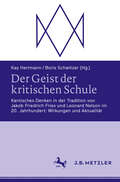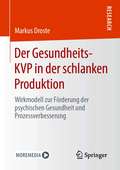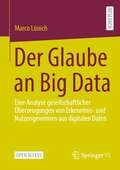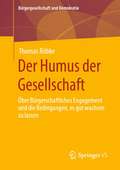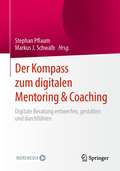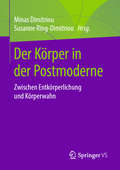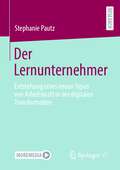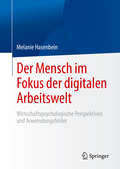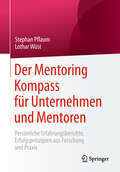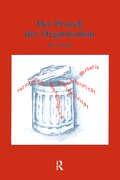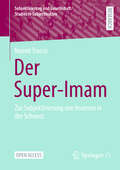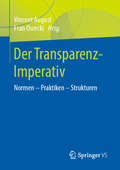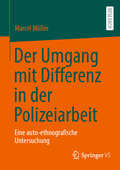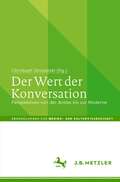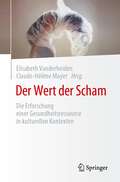- Table View
- List View
Der Geist der kritischen Schule: Kantisches Denken in der Tradition von Jakob Friedrich Fries und Leonard Nelson im 20. Jahrhundert: Wirkungen und Aktualität
by Kay Herrmann Boris SchwitzerPhilosophie als Wissenschaft, als Grundlagendisziplin und als interdisziplinäre Forschung: Ansätze, die sich eine zu Unrecht fast vergessene philosophische Schule zu eigen gemacht hat, nämlich die 1903 neu gegründete Fries’sche Schule um den Göttinger Philosophen Leonard Nelson (1882-1927). Sie steht in der Tradition der Philosophie Immanuel Kants (1724-1804) und Jakob Friedrich Fries' (1773-1843). Der Nelsonkreis hält dem Vergleich mit dem Wiener Kreis stand. Die Anhänger des Nelsonkreises kamen u.a. aus der Mathematik, Physik, Philosophie, Psychologie, Theologie und den Sozial- und Wirtschaftswissenschaften. Über sie wirkte die kantisch-friessche Philosophie teilweise in andere Disziplinen hinein. Zu nennen sind beispielsweise der Psychiater und Psychologe Arthur Kronfeld (1846-1941), der Biochemiker und Nobelpreisträger Otto Meyerhof (1884-1951), der Mathematiker Gerhard Hessenberg (1874-1925), die Philosophin und Physikerin Grete Henry-Hermann (1901-1984), die Pädagogin MinnaSpecht (1879-1961), der Wirtschaftswissenschaftler Alexander Rüstow (1885-1963), der Theologe Rudolf Otto (1869-1937), der Soziologe Franz Oppenheimer (1864-1943) und der Sozialwissenschaftler Gerhard Weisser (1898-1989).Die Ausstrahlung des Nelsonkreises auf verschiedene Disziplinen sowie dessen Geschichte sind bislang noch nicht umfassend untersucht worden. Diese Forschungslücke soll mit dem vorliegenden Band geschlossen werden. Der systematische Forschungsband bietet zudem eine Einführung und einen Überblick zur Philosophie Leonard Nelsons.
Der Gesundheits-KVP in der schlanken Produktion: Wirkmodell zur Förderung der psychischen Gesundheit und Prozessverbesserung
by Markus DrosteDie psychische Gesundheit von Produktionsmitarbeitern ist ein entscheidender Wettbewerbsfaktor für das wirtschaftliche Überleben von produzierenden Unternehmen, wird jedoch in Wissenschaft und Praxis bis heute nicht ausreichend betrachtet. Markus Droste belegt empirisch die Zusammenhänge von schlanken Arbeits- und Organisationsbedingungen, psychischer Gesundheit und kontinuierlichen Verbesserungsprozessen. Er entwickelt ein integriertes Modell, mit dem Unternehmen sowohl die Gesundheit ihrer Mitarbeiter als auch ihre Produktionsprozesse nachhaltig verbessern können.
Der Glaube an Big Data: Eine Analyse gesellschaftlicher Überzeugungen von Erkenntnis- und Nutzengewinnen aus digitalen Daten
by Marco LünichIn diesem Open-Access-Buch geht Marco Lünich der Annahme verbreiteter Glaubensüberzeugungen von der Qualität und Wirkmächtigkeit von Big Data nach und analysiert die miteinander in Bezug stehenden gesellschaftlichen Überzeugungen von Erkenntnis- und Nutzengewinnen aus Big Data. Das Aufkommen der digitalen Gesellschaft ist eng verbunden mit wirkmächtigen Narrativen wie etwa der Informations- und Wissensgesellschaft. In diesem Zusammenhang wird auch die Möglichkeit der weitreichenden Sammlung und Auswertung von großen digitalen Datenbeständen betont, den sogenannten Big Data. Hervorgehoben wird dabei die besondere Bedeutung von Big Data für die gesellschaftliche Erkenntnis- und Wissensproduktion und den hieraus gezogenen Nutzen. Daher wurde in der Literatur vielfach vermutet, dass sich die Überzeugung von den vermeintlichen Konsequenzen einer Quantifizierung der Welt und vor allem des Sozialen auch in den Köpfen der Menschen verfängt und hierdurch einstellungs- und handlungsrelevant wird. Dieser vermutete Zusammenhang wird im vorliegenden Buch in unterschiedlichen Forschungszusammenhängen des Einsatzes von Technologien Künstlicher Intelligenz empirisch geprüft.
Der Himmel ist nicht genug – Wissenschaft ist die beste Religion
by Hanna HeikenwälderDie Naturwissenschaft beschäftigt sich mit denselben großen Fragen wie Religion und Philosophie. Dabei verlässt sie sich jedoch nicht auf menschliche Vorlieben, Eingebung oder Logik, sondern erforscht unvoreingenommen die Natur. Ihr ewiges Hinterfragen, Testen und Korrigieren ist ehrlicher und demütiger, als veraltete Weltanschauungen und Konzepte kritiklos als „Palliativbehandlung“ gegen Ängste und Sorgen zu akzeptieren. Die Existenz von Atomen und Naturgesetzen ist keineswegs gleichbedeutend mit einer „Entzauberung“ des Lebens oder dem Verlust aller „erhabenen“ Gefühle - nur weil wir nicht mit Unwahrheiten um uns werfen dürfen. Die Natur hält spannendere und faszinierendere Wunder und Rätsel für uns bereit, als alle Formen von zusammenhangslosem Aberglaube, Mystizismus oder Verschwörungstheorien:Was geschah beim Urknall und welche Form hat das Universum? Sind wir allein im Universum?Was hat es mit der geheimnisvollen dunklen Energie auf sich? Warum altern wir in der Nähe Schwarzer Löcher langsamer? Und was ist eigentlich eine Weltformel, nach der alle so verzweifelt suchen?Zweifeln ist keine Schwäche, sondern eine ganz besondere Stärke. Ohne die Fähigkeit Fehler zu erkennen und die Bereitschaft, sich immer wieder selbst zu korrigieren, kämen wir der Wahrheit niemals näher. In ihrer kreativen Unvoreingenommenheit lehnen Naturwissenschaftler überirdische Schöpfer unseres Universums nicht kategorisch ab. Sie wollen einfach nur wissen, was wirklich stimmt.
Der Humus der Gesellschaft: Über bürgerschaftliches Engagement und die Bedingungen, es gut wachsen zu lassen (Bürgergesellschaft und Demokratie)
by Thomas RöbkeDieses Buch setzt sich mit bürgerschaftlichem Engagement aus verschiedenen Perspektiven auseinander. So wird u.a. bürgerschaftliches Engagement als demokratisches Heilmittel, Innovationsmotor oder Gestaltungskraft für demografischen Wandel diskutiert. Was bewegt Menschen überhaupt, sich für andere zu engagieren und in welchen Formen tun sie dies? Seine Wirkung entfaltet bürgerschaftliches Engagement besonders dann, wenn zivilgesellschaftliche Netzwerke und eine vorausschauende Engagementpolitik für entsprechende Rahmenbedingungen und Förderung sorgen.
Der Islam in der globalen Moderne: Soziologische Theorie und die Vielfalt islamischer Modernitäten (Politik und Gesellschaft des Nahen Ostens)
by Dietrich JungDieses Buch vereint soziologische Theoriebildung mit Studien zum Nahen Osten und zum Islam. Die Vielfalt von Modernitäten, die in unsere Welt beobachtet werden kann, wird dabei mit dem Anspruch verbunden, gleichzeitig in einer globalen Moderne, in einer Weltgesellschaft zu leben. Das Buch untermauert diesen Anspruch mit zahlreichen Exkursen in die islamische Geschichte. Es kritisiert die Auffassung, dass Modernisierung mit Verwestlichung gleichzusetzen wäre und betrachtet unterschiedliche Projekte von spezifisch islamischen Modernitäten als integrale Teile der Weltgesellschaft. Aus dieser Perspektive leistet die Studie einen Beitrag zur „Provinzialisierung“ der europäischen Geschichte im zeitgenössischen sozialwissenschaftlichen Denken. Entgegen den mit der Aufforderung zur Provinzialisierung Europas verbundenen Theorien des Postkolonialismus hält dieses Buch aber an wesentlichen Traditionen der klassischen Soziologie fest. Es will damit einen Beitrag zur sozialtheoretischen Diskussion um die Moderne leisten, der empirisch mit Hilfe von Daten aus der Geschichte des Nahen Ostens und des Islams untermauert wird.
Der Klimaschutzdiskurs der „Neuen Rechten“: Eine ideengeschichtliche Analyse des Periodikums Die Kehre – Zeitschrift für Naturschutz (BestMasters)
by Wiebke ZimmermannUmwelt- wie auch konkret der Klimaschutz als dessen jüngerer Teilbereich sind weder neutrale Sachthemen noch notwendigerweise politisch links zu verorten. Im historischen Rückblick lassen sich Momente der geglückten wie gescheiterten Verquickung nationalistischer und antidemokratischer Positionen mit „grünen“ Forderungen im gesellschaftspolitischen Diskurs ausmachen. Auch im Lichte des gegenwärtigen Relevanzgewinns der Causa Klimawandel regen sich im neurechten Lager erneut die Versuche einer (Rück-)Eroberung der Diskurshoheit. Paradigmatisch hierfür steht das neurechte Periodikum Die Kehre – Zeitschrift für Naturschutz, das sich als Debattenort zur Etablierung einer „konservativen Ökologie“, der Verbindung von Ökologie mit rechtsideologischen Elementen, ins Werk setzt. Welche Positionen beziehen, welche Begründungzusammenhänge formulieren Akteur*innen der „Neuen Rechten“ zum Klimaschutz? Die vorliegende Arbeit rekonstruiert Amalgamierungsmomente neurechter (Vorläufer-)Gruppierungen mit Themen des Umweltschutzes und systematisiert so die Chronologie der Genese der „Neuen Rechten“ in einem umweltethischen Zusammenhang. Auf diesem Fundament wird eine Tiefenanalyse der klimaschutzpolitischen Argumentationen innerhalb des neurechten Periodikums Die Kehre geleistet, die identifizierten Positionen werden hinsichtlich ihrer inhaltlichen und strukturellen Brücken in neurechte Traditions- und Ideologiebestände kontextualisiert und interpretiert.
Der Kompass zum digitalen Mentoring & Coaching: Digitale Beratung entwerfen, gestalten und durchführen
by Stephan Pflaum Markus J. SchwalbDas Buch gibt den Lesern einen praxisnahen Einblick in das Thema Digitalisierung von Beratungsprozessen im Coaching und Mentoring. 2020 war auf der ganzen Welt ein herausforderndes Jahr und wie es aussieht, werden uns diese Herausforderungen auch in 2021 begleiten. Große Teile der arbeitenden Welt fanden sich von einem Tag auf den anderen im Homeoffice wieder. Von der Grundschule bis in die Vorstandsebene, überall traten Zoom, Teams, Jitsi, WebEx, BigBlueButton ihren Siegeszug an und dominierten unsere Kommunikation. Einerseits gab diese Entwicklung der Digitalisierung einen enormen Entwicklungsschub. Andererseits aber fehlte uns allen die Zeit, sich auf diese Entwicklungen einzustellen. Vor allem die Bereiche, in denen die direkte zwischen-menschliche Kommunikation besonders wichtig ist, Beratung, Coaching und Mentoring waren betroffen. Aus dieser Situation heraus entstand die Idee für dieses Buch. Die Herausgeber und Autoren arbeiten seit vielen Jahren in den genannten Bereichen und sammelten und dokumentierten ihre Erfahrungen in 2020.
Der Körper in der Postmoderne: Zwischen Entkörperlichung und Körperwahn
by Minas Dimitriou Susanne Ring-DimitriouIn diesem Band befassen sich die Autorinnen und Autoren mit der Thematik „Körper in der Postmoderne“ aus der Sicht unterschiedlicher fachwissenschaftlicher Disziplinen. In den Vordergrund des Interesses rücken neben der Frage nach der Art und Weise des Verständnisses des menschlichen Körpers als komplexes gesellschaftliches Phänomen, auch die Erscheinungsformen und Artikulationslinien des postmodernen Körpers.
Der Lernunternehmer: Entstehung eines neuen Typus von Arbeitskraft in der digitalen Transformation
by Stephanie PautzDie digitale Transformation beschreibt den derzeitigen gesellschaftlichen Veränderungsprozess, der maßgeblich durch die Weiterentwicklung von Informationstechnologien bestimmt wird. Das Thema Lernen rückt damit in den Fokus. Menschen können darüber aktiv diesen Wandel gestalten und sich anpassen, um ihre grundlegenden psychologischen Bedürfnisse nach Kompetenzerleben, sozialer Eingebundenheit und Autonomie zu befriedigen. Allerdings verdichten sich auch die Anforderungen an sogenannte Wissensarbeiter, die in diesem Buch fokussiert werden. Herauszufinden wie sich die Arbeit durch Lernen verändert, bildet den Schwerpunkt. Ausgangspunkt ist die Arbeitskraftunternehmer-These, die Ende des 20. Jahrhunderts formuliert wurde. Thematisiert wird eine weitere Subjektivierung von Arbeit durch die Abkehr vom tayloristisch-fordistischen Arbeitsmodell. Den Arbeitskraftunternehmer zeichnet ein unternehmerischer Umgang mit der eigenen Arbeitskraft aus. In diesem Buch wird ein neues Modell eines Arbeitskrafttypus (Lernunternehmer) entwickelt, auf dessen Basis der weitere Wandel von Arbeit und Lernen untersucht wird. Die Schlussfolgerungen zu dieser Untersuchung bilden die Basis für entsprechende Handlungsempfehlungen zur Gestaltung arbeitsorientierten Lernens und lernhaltigen Arbeitens von Wissensarbeitern.
Der Mensch im Fokus der digitalen Arbeitswelt: Wirtschaftspsychologische Perspektiven und Anwendungsfelder
by Melanie HasenbeinDieses Fachbuch zeigt Ihnen auf, welche Auswirkungen die Digitalisierung auf den Menschen in der heutigen Arbeits- und Organisationswelt hat. Dabei begleitet Sie das Werk auf der digitalen Reise durch die wirtschaftspsychologischen Themenbereiche. Basierend auf gut vermitteltem theoretischen Hintergrundwissen und fundiert mit aktuellen Studien und praktischen Umsetzungsmöglichkeiten erfahren Sie:zentrale Veränderungen im Organisations- und Personalbereich welche Führungsansätze und -kompetenzen in digitalen Zeiten relevant sind welchen Einfluss dies auf die Teamarbeit hatwelche aktuellen digitalen Lernformate Anwendung finden undwelche Bedeutung die Themen digitale Balance und Ethik in der Digitalisierung haben.Zielgruppen:Professionals im Organisations- und Personalbereich sowie Berater, Coaches und Trainer als auch Studierende der Wirtschaftspsychologie und der Angewandten Psychologie. Zur Autorin: Dr. Melanie Hasenbein ist als Organisationsdesignerin und Coach für digitale Veränderungsprozesse und als Autorin zu Themen der digitalen Psychologie und Pädagogik tätig.
Der Mensch spiegelt sich im Blick der Tiere: Auflösung und Neudefinition des Menschen in der Exilliteratur (Exil-Kulturen #9)
by Carla SwiderskiWas ist der Mensch und wie verhält er sich zum Tier? Wird diese Frage in ethischen, gesellschaftlichen, philosophischen und ästhetischen Diskursen seit der Antike debattiert, stellt sie sich im 20. Jahrhundert angesichts der NS-Diktatur und ihrer Verbrechen gegen die Menschlichkeit in einem besonders bedrohlichen Umfeld. Wie wirkt sich dies auf das nachfolgende Verständnis von Mensch und Tier aus? – Die vorliegende Arbeit untersucht Mensch-Tier-Konstellationen in fiktionalen und theoretischen Texten, die im durch das NS-Regime verursachten Exil entstanden sind. Dabei werden Fragen der Exilforschung mit Fragen der Literary und Cultural Animal Studies zusammengedacht. Ausführlich analysiert werden Texte von Victor Klemperer, Alexander Bein, Hannah Arendt, Max Horkheimer und Theodor W. Adorno, Hermann Broch, Oskar Maria Graf, Alfred Kerr, Hilde Domin und Hans Sahl.
Der Mentoring Kompass für Unternehmen und Mentoren: Persönliche Erfahrungsberichte, Erfolgsprinzipien aus Forschung und Praxis
by Stephan Pflaum Lothar WüstMentoring ist ein vielversprechendes Beratungskonzept, um die Karrieren junger Akademiker und Fachkräfte gezielt zu fördern. Das vorliegende Arbeitsbuch richtet sich gleichermaßen an Mentoren und Mentees, die eine Mentoringbeziehung während des Studiums oder am Beginn ihrer Karriere aufbauen und erfolgreich gestalten wollen. Neben einer Einführung in die grundlegenden Methoden der Beratung im Mentoringprozess bietet das Buch eine anwendungsorientierte Best-Practice-Sammlung zur erfolgreichen Gestaltung der Beziehung zwischen Mentor und Mentee.
Der ProzeB der Organisation
by Peter PelzerFirst Published in 1995. Das Buch ist ein ernsthafter Versuch, die anregende Wirkung der Auseinandersetzung mit anderen Wissensgebieten aufzuzeigen, die auf den ersten Blick nichts mit dem eigenen Arbeitsfeld zu tun haben, sondern die Wahrnehmung von Entwicklungen schärfen, die nur in einem breiteren Wettbewerb bewertet werden können, wird mit einer Untersuchung des gegensätzlichen Paares von Subjektivismus und Objektivismus fortgesetzt, gefolgt von einer Auseinandersetzung mit dem Konzept der Postmoderne. Im vierten Teil werden die Konzepte der ersten beiden Teile im Lichte des dritten Teils erneut untersucht.
Der Russland-Ukraine-Krieg: Lösungsperspektiven aus der Friedensforschung (Innovativ und kompakt – gesellschaftliche Herausforderungen der Gegenwart)
by Karim FathiDer Krieg in der Ukraine hält die Welt in Atem. Die aktuelle Berichterstattung ist emotionalisiert und beschränkt sich weitgehend auf die militärischen Entwicklungen des Kriegsverlaufs. Beiträge der Friedens- und Konfliktforschung wurden und werden in der aktuellen Debatte nur unzureichend berücksichtigt. Sie sind sogar Gegenstand antipazifistischer Kritik. Wenig findet sich zu der Frage, was für einen nachhaltigen Frieden notwendig wäre. Diese Frage ist umso wichtiger, als dieser Krieg in seinen Tiefendimensionen eine hochbrisante globale Tragweite aufweist, mit indirekten Verbindungen zu anderen Territorialkonflikten, wie z.B. dem China-Taiwan-Konflikt. Parallel zum Krieg ist eine zunehmende globale Blockbildung zwischen Ost und West mit ungewissem Ausgang zu beobachten. Einige Beobachter*innen sprechen von einem „Neuen Kalten Krieg“ mit den beiden Supermächten USA und China sowie der EU und Russland als Hauptakteuren. Gleichzeitig scheint der Krieg als Katalysator für eine neue multilaterale Weltordnung zu wirken. Das Buch skizziert in knapper und allgemeinverständlicher Form, wie eine multidimensionale Analyse komplexer Konflikte wie des Russland-Ukraine-Krieges angegangen werden kann und wie sich daraus auch Ansätze für eine komplexitätsadäquate Konfliktintervention und Außenpolitik ableiten lassen. Darüber hinaus werden Impulse für die Weiterentwicklung der Friedensforschung zu einem multiparadigmatischen Forschungsfeld gegeben.
Der Staat als ‚Guter Auftraggeber‘? Öffentliche Auftragsvergabe zwischen Vermarktlichung und Sozialpolitisierung
by Karen Jaehrling Christin StiehmDiese Open-Access-Publikation befasst sich mit den vielfältigen Entscheidungsprozessen, mit denen der Bieterwettbewerb um öffentliche Aufträge gestaltet wird und fragt, inwieweit dabei versucht wird, gute Arbeitsbedingungen für die Beschäftigten beauftragter Unternehmen zu gewährleisten. Inwieweit bemüht sich der Staat als ‚Guter Auftraggeber‘ die Lücken der kollektiven Selbstregulierung des Arbeitsmarktes (durch Tarifverträge, betriebliche Mitbestimmung) zu schließen – oder trägt im Gegenteil dazu bei, sie zu vertiefen? Neben einer Analyse der Gesetzesentwicklung auf europäischer und nationaler Ebene bilden Fallstudien zur Vergabepraxis auf kommunaler Ebene in Deutschland das Kernstück der empirischen Erhebung. Die Befunde verdeutlichen, dass die Vergabepolitik und -praxis durch widersprüchliche Trends geprägt wird: Zum einen durch die Intensivierung von Marktprinzipien (Vermarktlichung), indem Regelungen und Praktiken, die dem Bieterwettbewerb zugunsten sozialer Ziele Schranken setzen, seit Beginn des Europäischen Binnenmarktes an immer restriktivere Bedingungen geknüpft worden sind. Dem stehen zum anderen verschiedene Ansätze gegenüber, sozialen Kriterien bei der Auftragsvergabe einen größeren Stellenwert einzuräumen (Sozialpolitisierung) – etwa durch Tariftreuebestimmungen. Dieses dauerhafte, institutionalisierte Nebeneinander widersprüchlicher Trends generiert Handlungsdilemmata für die kommunale Politik und Verwaltung, wie auch für die Akteure der industriellen Beziehungen. Das Buch beleuchtet ihre Strategien und Lernprozesse im Umgang mit diesen Dilemmata.
Der Strafvollzug als Zwischenstation der Radikalisierung: Eine Studie zu Strafgefangenen und Haftentlassenen muslimischen Glaubens anhand biographisch-narrativer Gesprächsführung (Islam in der Gesellschaft)
by Samet ErEs gibt nur wenige wissenschaftliche Forschungen zur islamistischen Radikalisierung im Strafvollzug. Auch ist wenig erforscht, wie mit diesem Phänomen umzugehen ist. Es fehlen Informationen darüber, welche Personen oder -gruppen sich im Strafvollzug oder nach der Entlassung radikalisiert haben. Das liegt u.a. an den spärlich vorhandenen und kaum verwertbaren Daten und Erfahrungswerten, da es sich noch um ein relativ junges Phänomen handelt. Im Buch werden (radikalisierte) Strafgefangene und Haftentlassene mehrmals und über einen längeren Zeitraum hinweg interviewt, um sie und ihr bisheriges Leben anhand ihrer Selbstdarstellung besser verstehen und nachvollziehen zu können. Die Auswertungen zeigen, dass Prozesse der Radikalisierung mit biographischer Sinnsuche und den Erfahrungen im Strafvollzug zusammenhängend auch nach der Entlassung stattfinden können.
Der Super-Imam: Zur Subjektivierung von Imamen in der Schweiz (Subjektivierung und Gesellschaft/Studies in Subjectivation)
by Noemi TruccoIn diesem Open-Access-Buch wird untersucht, wie Imame in der Schweiz mit den vielfältigen Anrufungen, Adressierungen, Zuschreibungen und Erwartungen in massenmedialen und politischen Debatten umgehen. Anhand einer empirischen Subjektivierungsanalyse wird die Machtwirkungen von Diskursen auf Selbst-Positionierungen von Imamen aufgezeigt. Herausgearbeitet wird, wie sich die spezifischen Debatten als konflikthafte Aushandlungen zur symbolischen Form der Schweizer Gesellschaft, die von einer Abgrenzung zum Fremden und damit einer sozialen Schließung geprägt sind, auf die Selbst-Positionierungen niederschlagen, aber auch in welcher Form Imame dennoch Agency haben.
Der Transparenz-Imperativ: Normen – Praktiken – Strukturen
by Vincent August Fran OsreckiDie Forderung nach „mehr Transparenz“ ist allgegenwärtig. Der Transparenz-Imperativ beschränkt sich dabei nicht auf die Politik; man begegnet ihm auch in Wirtschaft und Wissenschaft, im Journalismus und im Gesundheitssystem. Wie konnte sich diese Norm derart durchsetzen? Hält Transparenz ihr Versprechen, mehr Vertrauen, Effizienz und Partizipation zu schaffen? Wie gestalten sich Strukturen, die im Namen von mehr Transparenz geschaffen wurden? Und wem nützen sie? Diese Fragen nimmt der Band in den Blick. Durch die Zusammenführung unterschiedlicher sozialwissenschaftlicher Ansätze wird deutlich: Transparenz ist eine modernistische Regierungsweise, die Misstrauen in Praktiken der Inspektion übersetzt. Sie macht soziale Prozesse für externe Laien sichtbar, indem sie standardisiert und formalisiert. Dabei erreicht sie aber selten das von ihr anvisierte Ziel: Transparenz schafft oft Intransparenz.
Der Umgang mit Differenz in der Polizeiarbeit: Eine auto-ethnografische Untersuchung
by Marcel MüllerIn dieser (auto-)ethnografischen Studie geht es in erster Linie um die Frage, wie sich verschiedene Differenzen – etwa sprachliche, ethnische, kulturelle oder sozio-ökonomische Unterschiede – auf die polizeiliche Praxis auswirken und wie Polizist*innen im Rahmen der Polizei-Bürger-Interaktion üblicherweise mit den verschiedenen Fremdheitsmarkierern umgehen. In diesem Kontext ist vor allem von Interesse, welche Ansätze und Strategien die Polizeibeamt*innen verfolgen, um die auftretenden (Verständnis-)Probleme im Alltag zu lösen und was geschieht, wenn es ihnen nicht gelingt, die auftretenden Differenzen zu überwinden. Dabei ist gleichermaßen von Bedeutung, in welchen Situationen die Beteiligten konkret zu einer Kulturalisierung (oder Entkulturalisierung) der Interaktion beitragen und was sie sich hiervon in der Regel versprechen. Hierbei fokussiert die Untersuchung ebenso auf die hiermit verbundenen Grenzziehungspraktiken der beteiligten Akteur*innen – und zwar nicht nur im Hinblick auf Polizei-Bürger-Interaktion, sondern auch hinsichtlich des Binnenlebens der Polizei als Institution.
Der Vater als Sozialfigur: Eine semantische Rekonstruktion und Funktionsanalyse des Vaters (Familienforschung)
by Timo BurgerIn dieser rekonstruktiv angelegten qualitativen Analyse wird aus systemtheoretischer Perspektive der Sozialfigur Vater nachgegangen. Ausgehend von einer historisch-genetischen Rekonstruktion der Fremdbeschreibung der gepflegten Vater-Semantik seit der Antike bis ins 21. Jahrhundert werden 14 Väter in problemzentrierten Interviews auf ihre Selbstbeschreibung hin dokumentarisch analysiert. Als Ergebnisse der Forschungsarbeit werden neben gegenwärtigen kommunikativen Spielräumen auch Rekursionen auf die im ersten Teil der Arbeit herausgestellte gepflegte Semantik deutlich, die im Sinne eines Trampelpfads komplexe Verweisungsstrukturen des kommunikativ Sagbaren abstecken.Der AutorTimo Burger war bis 2017 wissenschaftlicher Mitarbeiter am Institut für Erziehungswissenschaft der JGU Mainz. Seit 2019 ist er Studienrat am Berufsbildungszentrum in Grevenbroich mit den Fächern Sozialpädagogik und Politik/Wirtschaftskunde.
Der Wert der Konversation: Perspektiven von der Antike bis zur Moderne (Abhandlungen zur Medien- und Kulturwissenschaft)
by Christoph StrosetzkiWoran wird der Wert der Konversation gemessen? Gibt es wertvollere und minderwertige Typen der Konversation? Welche Rolle kommt den Inhalten, den Personen und den Umständen zu? Prägen Zeiten und Epochen die je ihnen eigenen Konversationen? Konversationsnormen aus Handbüchern ebenso wie in Texten wiedergegebene oder aus Texten rekonstruierte Konversationen geben Aufschluss über diese Fragen. Die Beiträge im vorliegenden Band gruppieren sich um begriffliche Fragen, bestimmte Kontexte wie den Salon und das Tischgespräch, bringen Studien zu einzelnen literarischen Texten und decken dabei die europäische Kulturgeschichte von Platon bis ins 20. Jahrhundert ab.
Der Wert der Scham: Die Erforschung einer Gesundheitsressource in kulturellen Kontexten
by Elisabeth Vanderheiden Claude-Hélène MayerDieser Band kombiniert empirisch-wissenschaftliche und theoretische Perspektiven auf Scham in kulturellen Kontexten und aus soziokulturell unterschiedlichen Perspektiven. Es bietet neue Einsichten und eine umfassendere kulturelle Basis für die zeitgenössische Forschung und Praxis im Kontext von Scham. Das Buch untersucht Scham aus der Perspektive der Positiven Psychologie, aus dem Blickwinkel der Definition des Konzepts als psychologisches und kulturelles Konstrukt und im Hinblick auf praktische Perspektiven in verschiedenen Kulturen.Der Band bietet eine solide Grundlage für Forscher:innen und Praktiker:innen, neue Modelle, Therapien und Beratungspraktiken zu entwickeln, um Scham neu zu definieren und so zu gestalten, dass sie zu Stärke, Resilienz und Stärkung des Individuums führt.
Der Zufall in Physik, Informatik und Philosophie: Zufall als Fundament der Welt (Die blaue Stunde der Informatik)
by Walter HehlDer Zufall ist uns unheimlich. Wir dachten, es gäbe ihn nicht, hinter allem stehe Gott oder eine vernünftige Erklärung. Aber wir wissen heute: Es gibt ihn. Wir wissen, dass vieles dessen, was uns umgibt und das wir nicht durchschauen, trotzdem kausal abläuft. Anders als zu Zeiten der Aufklärung gedacht, ist der Zufall um uns eher die Regel als die gesetzmäßige Ordnung. Die Wolken sind Fraktale, die Wellen auf dem Meer sind eine reine Zufallsmaschinerie. Der Philosoph Charles Peirce hat genau in diesem Sinn noch vor Quanten- und Chaostheorie die fundamentale Bedeutung des Zufalls erkannt und der Lehre ihren Namen gegeben: Tychismus.Ohne Zufall gäbe es nichts Neues, kein Leben, keine Kreativität, keine Geschichte.Dieses Buch betrachtet den Zufall aus Sicht der Physik, der Informatik und der Philosophie. Es spannt den Bogen von der Antike zur Quantenphysik und zeigt, dass der Zufall fest in die Welt eingebaut ist und es sie ohne Zufall nicht gäbe.
Der Zusammenhang zwischen Meritokratie und beruflicher Bildung: Idealtypische Rekonstruktion als Deutungsrahmen für das Wertschätzungsproblem der Berufsbildung in der Ukraine (Internationale Berufsbildungsforschung)
by Vera BraunDieses Open-Access-Buch beschäftigt sich mit dem Einfluss des meritokratischen Prinzips auf die Wertschätzung beruflicher Bildung gegenüber allgemeiner bzw. akademischer Bildung. Diesen Einfluss untersucht die Autorin sowohl allgemein, das heißt auf idealtypischer Ebene, als auch in Bezug auf die Ukraine. Als Ergebnis zeigt die Studie, dass das meritokratische Leistungsprinzip idealtypisch und auch im Falle der Ukraine als Katalysator für nachteilige Entwicklungen wirkt, was die Wertschätzung beruflicher Bildung und die Erfüllung ihrer gesellschaftlichen Funktion anbelangt.
